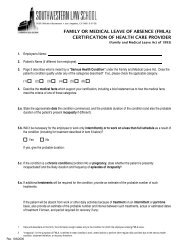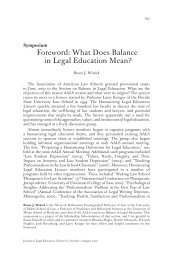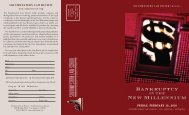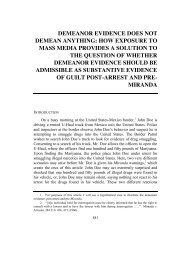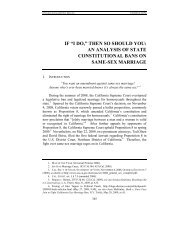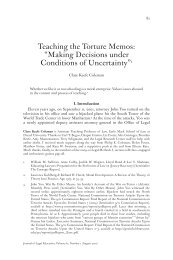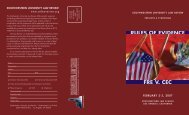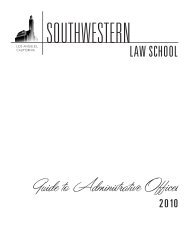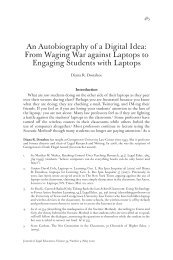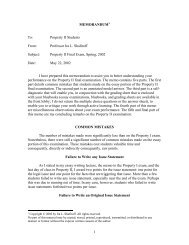What is Art? - Southwestern Law School
What is Art? - Southwestern Law School
What is Art? - Southwestern Law School
- No tags were found...
You also want an ePaper? Increase the reach of your titles
YUMPU automatically turns print PDFs into web optimized ePapers that Google loves.
WHAT IS ART? 123h<strong>is</strong> art<strong>is</strong>tic reputation. To do so, he and h<strong>is</strong> lawyer had to convince thejury of h<strong>is</strong> art<strong>is</strong>tic abilities and standing.Study of Wh<strong>is</strong>tler’s cross-examination reveals the heart of Ruskin’sline of defence. Question: “<strong>What</strong> <strong>is</strong> the subject of Nocturne in Blackand Gold: The Falling Rocket?” Wh<strong>is</strong>tler: “It <strong>is</strong> a night piece and representsthe fireworks at Cremorne Gardens.” Question: “Not a view ofCremorne?” Answer: “If it were A View of Cremorne it would certainlybring about nothing but d<strong>is</strong>appointment on the part of the beholders.It <strong>is</strong> an art<strong>is</strong>tic arrangement. That <strong>is</strong> why I call it a nocturne.”Question: “Did it take you much time to paint the Nocturne in Blackand Gold? How soon did you knock it off?” Answer: “Oh, I ‘knockone off ’ possibly in a couple of days—one day to do the work and anotherto fin<strong>is</strong>h it ...”.Question: “The labour of two days <strong>is</strong> that forwhich you ask two hundred guineas?” Answer: “No, I ask it for theknowledge I have gained in the work of a lifetime.” 57Wh<strong>is</strong>tler was the David of the forensic set-piece, Ruskin the Goliath.Wh<strong>is</strong>tler’s many art<strong>is</strong>t peers and supporters, who had prom<strong>is</strong>ed to give evidence,failed to do so; Ruskin’s did, including Burne-Jones. The jury’stask was invidious: effectively, whether to recogn<strong>is</strong>e art<strong>is</strong>tic merit inthe (then) unorthodox ‘modern’ painting style of so-called impression<strong>is</strong>m;and, if so, to place a monetary value on Ruskin’s damage to Wh<strong>is</strong>tler’sprofessional reputation. Ruskin was found guilty, and ordered topay one farthing 58 in damages. Costs were borne by each party. Such der<strong>is</strong>oryawards were commonplace at the time, whenever juries in civil trialswere faced with “a delicate and ultimately insoluble legal dilemma.” 59Th<strong>is</strong> <strong>is</strong> arguably the last time an art<strong>is</strong>t sued a critic for defamation.The courtroom <strong>is</strong> clearly the wrong place for a forensic fight over aestheticmerit. Indeed, it has often been said over the intervening centurythat Wh<strong>is</strong>tler’s lawyers would have been w<strong>is</strong>er to claim (if at all) damageto Wh<strong>is</strong>tler’s sales of work (of which there was ample hard evidencefollowing Ruskin’s public attack), rather than damage to h<strong>is</strong>art<strong>is</strong>tic competence.We now consider the landmark trial of art initiated by a progenitorof Modern <strong>Art</strong>, often referred to as the Patriarch of Modern Sculpture,Romanian art<strong>is</strong>t Constantin Brâncuşi. 6057. PETRA TEN-DOESSCHATE CHU, NINETEENTH CENTURY EUROPEAN ART 349.58. Th<strong>is</strong> was the lowest value coin of the Realm.59. Franc<strong>is</strong> L. Fennell, The Verdict in Wh<strong>is</strong>tler v. Ruskin, VICTORIAN NEWSLETTER,Fall 1971, at 17, 21.60. Constantin Brâncuşi (1876–1957) was an Abstract Expression<strong>is</strong>t sculptor, bornin Romania, who settled and remained in Par<strong>is</strong>, France from 1904.



